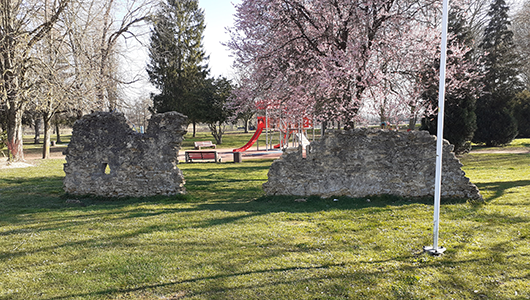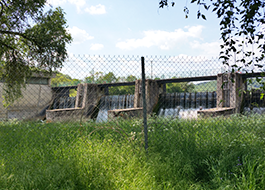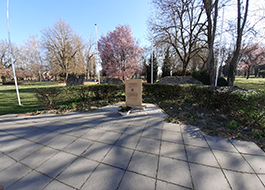Maizières-lès-Metz
Durée visite : 30 min
Moyen : pédestre
De sa première attestation en 977 et jusqu’à la Révolution française, Maizières est une possession de l’abbaye Saint-Vincent de Metz. En 1685, comme ailleurs dans le royaume, les protestants locaux s’exilent après la Révocation de l’Edit de Nantes. Deux de leurs descendants sont célèbres. Lothar de Maizière est le premier et dernier Ministre-président démocratiquement élu de la RDA, après la chute du Mur. Son cousin Thomas a été plusieurs fois ministre dans les gouvernements d’Angela Merkel. De 1882 à 1898 fonctionnent une usine à fonte et ses trois hauts-fourneaux. Une autre est construite en 1905. Quatre hauts-fourneaux produisent 900t par jour avant 1940. Dévastés en 1944, ils ne seront pas rebâtis. En septembre 1944, Macheren bei Metz vit s’affronter des unités de la IIIe armée US et la 559e division d’infanterie allemande. Les habitants ont été évacués ou ont fui vers l’Est. Des soldats de la 462e Volks-Grenadier-Division résiste longtemps à la 90e DI. Fin octobre, l’artillerie américaine pilonne les positions ennemies en détruisant une grande partie de la ville. Le 30 octobre Patton entre en vainqueur dans les ruines de Maizières.
From its first certificate in 977 until the French Revolution, Maizières is a possession of the Abbey of Saint-Vincent de Metz. In 1685, as elsewhere in the kingdom, the local Protestants went into exile after the Revocation of the Edict of Nantes. Two of their descendants are famous. Lothar de Maizière is the first and last democratically elected Minister-President of the GDR after the fall of the Wall. His cousin Thomas was several times minister in Angela Merkel’s governments. From 1882 to 1898 a cast iron factory and its three blast furnaces operated. Another was built in 1905. Four blast furnaces produced 900t per day before 1940. Devastated in 1944, they will not be rebuilt. In September 1944, Macheren bei Metz saw units of the Third US Army and the 559th German Infantry Division clash. Residents were evacuated or fled to the east. Soldiers of the 462nd Volks-Grenadier-Division long resisted the 90th ID. At the end of October, the American artillery pounded enemy positions, destroying a large part of the city. On October 30, Patton entered the ruins of Maizières as a winner.
Von seiner ersten Bescheinigung im Jahr 977 bis zur Französischen Revolution ist Maizières im Besitz der Abtei von Saint-Vincent de Metz. Wie überall im Königreich gingen die örtlichen Protestanten 1685 nach der Aufhebung des Edikts von Nantes ins Exil. Zwei ihrer Nachkommen sind berühmt. Lothar de Maizière ist der erste und letzte demokratisch gewählte Ministerpräsident der DDR nach dem Fall der Mauer. Sein Cousin Thomas war mehrmals Minister in Angela Merkels Regierungen. Von 1882 bis 1898 war eine Gusseisenfabrik mit ihren drei Hochöfen in Betrieb. Ein weiterer wurde 1905 gebaut. Vier Hochöfen produzierten vor 1940 900 t pro Tag. 1944 zerstört, werden sie nicht wieder aufgebaut. Im September 1944 kam es in Macheren bei Metz zu Zusammenstößen zwischen Einheiten der Dritten US-Armee und der 559. Deutschen Infanteriedivision. Die Bewohner wurden evakuiert oder flohen nach Osten. Soldaten der 462. Volks-Grenadier-Division widersetzten sich lange der 90. ID. Ende Oktober schlug die amerikanische Artillerie auf feindliche Stellungen ein und zerstörte einen großen Teil der Stadt. Am 30. Oktober betrat Patton als Sieger die Ruinen von Maizières.

De gueules à trois besants d’or, le premier chargé d’une croix pattée. et une fleur de lys d’argent d’où naissent deux palmes de sinople en abîme.
La fleur de lys est l’emblème de l’abbaye de Saint-Vincent, qui possédait la seigneurie de Maizières. Les besants d’or sont les armes du Val de Metz, partie du Pays messin à laquelle appartenait Maizières.
Gules with three bezants of gold, the first charged with a cross pattée. and a fleur-de-lis of silver from which are born two palms Vert in abyss.
The fleur-de-lys is the emblem of the abbey of Saint-Vincent, which owned the seigneury of Maizières. The golden besants are the arms of the Val de Metz, part of the Pays Metz to which Maizières belonged.
Gules mit drei Bezants von Gold der erste, der mit einem Kreuzmuster beladen ist. und eine Lilie aus Silber, aus der zwei Palmen Vert im Abgrund geboren werden.
Die Lilie ist das Wahrzeichen der Abtei von Saint-Vincent, der das Seigneury von Maizières gehörte. Die goldenen Besants sind die Arme des Val de Metz, Teil des Pays Metz, zu dem Maizières gehörte.

Les habitants et les habitantes de Maizières-lès-Metz s’appellent les Maiziérois et les Maiziéroises.
The inhabitants of Maizières-lès-Metz are called the Maiziérois and the Maiziéroises.
Die Einwohner von Maizières-lès-Metz heißen Maiziérois und Maiziéroises.
Les points de visites
Cette bâtisse moderne est l’œuvre de Jean Rouquet. On lui doit entre autres Notre-Dame du Rosaire à Rézé (44) ou le campanile du Sacré- Chœur de Bourges(18). La première pierre fut posée en 1959 ; et l’ensemble, consacré le 16 décembre 1961. C’était déjà une église avant de faire les frais de la Seconde Guerre mondiale. Sa capacité d’accueil est de 800 personnes.
This modern building is the work of Jean Rouquet. We owe him, among others, Notre-Dame du Rosaire in Rézé (44) or the campanile of the Sacré-Chœur de Bourges (18). The first stone was laid in 1959; and the whole, consecrated on December 16, 1961. It was already a church before paying the price of the Second World War. It has a capacity of 800 people.
Dieses moderne Gebäude ist das Werk von Jean Rouquet. Wir schulden ihm unter anderem Notre-Dame du Rosaire in Rézé (44) oder den Glockenturm des Sacré-Chœur de Bourges (18). Der erste Stein wurde 1959 gelegt; und das Ganze, geweiht am 16. Dezember 1961. Es war bereits eine Kirche, bevor es den Preis des Zweiten Weltkriegs bezahlte. Es hat eine Kapazität von 800 Personen.
.
Maizières-lès-Metz possède deux monuments aux morts. L’un rend hommage aux victimes de la Première Guerre mondiale (1914-1918) l’autre, à celles du second conflit mondial (1940-1945) Le premier se trouve place des Déportés et arbore l’inscription suivante ; « À nos morts – Le souvenir français ». On le reconnaît à sa croix de Lorraine et à la statue de soldat qui trône sur son piédestal. Le second monument se situe rue du 4 Septembre. On peut y lire : « La ville de Maizières-lès-Metz à ses enfants morts pour la France »
Maizières-lès-Metz has two war memorials. One pays homage to the victims of the First World War (1914-1918) the other, to those of the Second World War (1940-1945) The first is in the Place des Déportés and bears the following inscription; « To our dead – The French memory ». He can be recognized by his cross of Lorraine and the statue of a soldier who sits on his pedestal. The second monument is located rue du 4 Septembre. We can read there: « The city of Maizières-lès-Metz to its children who died for France »
Maizières-lès-Metz hat zwei Kriegsdenkmäler. Man huldigt den Opfern des Ersten Weltkriegs (1914-1918) die andere zu denen des Zweiten Weltkriegs (1940-1945) Die erste befindet sich am Place des Déportés und trägt die folgende Inschrift; « Zu unseren Toten – Die französische Erinnerung ». Er ist an seinem Lothringerkreuz und der Statue eines Soldaten zu erkennen, der auf seinem Sockel sitzt. Das zweite Denkmal befindet sich in der Rue du 4 Septembre. Wir können dort lesen: « Die Stadt Maizières-lès-Metz an ihre Kinder, die für Frankreich gestorben sind »
.
La 95e DI apparaît en 1918 mais trop tardivement pour être engagée lors de la Première Guerre mondiale. Elle est maintenue comme force de réserve jusqu’à la Seconde Guerre mondiale, où elle est envoyée en Europe. Entre le 9 novembre 1944 et le 14 novembre 1944, une opération de franchissement de la Moselle est effectuée dans le secteur de Thionville par les Alliés. La division engagée est la 95e division d’infanterie américaine appartenant au XXe corps de la 3e armée US du général Patton. Elle s’illustre ensuite dans la libération puis la défense de la ville de Metz, où elle gagne son surnom d’« Iron Men of Metz » ou« les hommes de fer de Metz » Après la guerre, la division est de nouveau mise en réserve quelque temps avant d’être activée à nouveau comme division d’entraînement.
It appears in 1918 but too late to be engaged in the First World War. It was maintained as a reserve force until World War II, when it was sent to Europe. Between November 9, 1944 and November 14, 1944, an operation to cross the Moselle was carried out in the Thionville sector by the Allies. The engaged division is the 95th American Infantry Division belonging to the XXth Corps of the 3rd US Army under General Patton. She then distinguished herself in the liberation and then the defense of the city of Metz, where she earned her nickname « Iron Men of Metz » « the iron men of Metz » After the war, the division is again put in reserve for some time before being activated again as a training division.
Es scheint 1918, aber zu spät, um sich auf den Ersten Weltkrieg einzulassen. Es wurde als Reservetruppe bis zum Zweiten Weltkrieg unterhalten, als es nach Europa geschickt wurde. Zwischen dem 9. November 1944 und dem 14. November 1944 wurde von den Alliierten eine Operation zur Überquerung der Mosel im Sektor Thionville durchgeführt. Die engagierte Division ist die 95. amerikanische Infanteriedivision des XX. Korps der 3. US-Armee unter General Patton. Sie zeichnete sich dann in der Befreiung und dann in der Verteidigung der Stadt Metz aus, wo sie ihren Spitznamen « Iron Men of Metz » oder »die Eisenmänner von Metz » erhielt. Nach dem Krieg wird die Division wieder für einige Zeit in Reserve gelegt, bevor sie wieder als Trainingsabteilung aktiviert wird.
.








